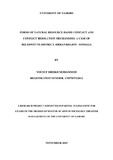| dc.description.abstract | This research aimed at studying the forms of natural resource-based conflict and conflict resolution mechanisms. Beledweyne District in Hiiran Region of Somalia was selected as the case for the study since it is the main town within the region whose suburbs are adversely affected by the phenomenon of natural resource-based conflict. Specifically, the study aimed at achieving the following objectives: To find out the main types in which natural resource-based conflict is manifested; to investigate the common triggers of natural resource-based conflict; to explore the main effects of natural resource-based conflict at community and family levels; and to ascertain the mechanisms of conflict resolution in natural resource-based conflict. In order to achieve the above-mentioned objectives, the study was divided into five main chapters, each with a number of sections and sub-sections. The study employed a descriptive research design, where opinions and attitudes of key informants were analyzed and presented. The sample size for the study was drawn from groups (strata) of women, youth, scholars, clan elders/religious leaders, local administrators and NGOs using both stratified and purposive random sampling procedures. Data was collected using key informant questionnaires.
The data that was collected was later subjected to both quantitative and qualitative analysis techniques, where quantitative data was analyzed using the SPSS tool, while qualitative data was analyzed using thematic grouping and content analysis. The analyzed data was interpreted and presented in form of frequency distribution tables, pie chart and bar graphs. From the findings, the study found that natural resource-based conflict was mainly manifested in terms of clan wars or conflicts, destruction of property, raiding of livestock, displacement of families and loss of human lives. The findings also revealed that lack of enough water and land for farming and grazing were some of the main causes or triggers of conflict in Beledweyne District. The study therefore recommends that there is need for the government and other key stakeholders to try and provide viable alternative solutions to the affected populations of natural resource-based conflicts. The study also recommends that there is need to encourage modern forms of farming and proper utilization of the available land – such as zero grazing, crop rotation, mixed farming and irrigation of semi-arid lands as alternatives to pastoralism and monoculture farming. There is also need for the government to provide biogas as an alternative to excessive cutting down of trees and charcoal-burning. | en_US |



